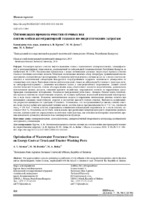| dc.contributor.author | Крутов, А. В. | |
| dc.contributor.author | Дечко, М. М. | |
| dc.contributor.author | Бойко, М. А. | |
| dc.coverage.spatial | Минск | ru |
| dc.date.accessioned | 2019-10-23T07:17:17Z | |
| dc.date.available | 2019-10-23T07:17:17Z | |
| dc.date.issued | 2019 | |
| dc.identifier.citation | Крутов, А. В. Оптимизация процесса очистки сточных вод постов мойки автотракторной техники по энергетическим затратам = Optimization of Wastewater Treatment Process on Energy Costs at Truck and Tractor Washing Posts / А. В. Крутов, М. М. Дечко, М. А. Бойко // Наука и техника. – 2019. – № 5. – С. 436-442. | ru |
| dc.identifier.uri | https://rep.bntu.by/handle/data/58172 | |
| dc.description.abstract | Рассмотрен процесс очистки нефтесодержащих стоков с применением электрокоагуляции, электрофлотации и электромагнитного гидроциклона, реализованный на лабораторной установке (патент Республики Беларусь на изобретение № 21229). Исследования проводились с целью оптимизации удельных энергозатрат процесса очистки стоков от топливно-смазочных веществ. Методами исследования являлись обзор литературы, сравнительный анализ, эксперимент, математическое моделирование. Содержание нефтепродуктов в сточных водах до и после очистки оценивалось в аналитической лаборатории Белорусского государственного аграрного технического университета по стандартным методикам. Выполнена очистка нефтесодержащих стоков на лабораторной установке с помощью метода электрофлотокоагуляции с удалением всплывшего шлама в электромагнитном гидроциклоне. Данный способ очистки позволяет повысить степень обеззараживания воды, обеспечивает замкнутое водоснабжение, рациональное использование водных ресурсов, снижение вредного воздействия загрязняющих веществ на окружающую среду. Проведено планирование эксперимента. Реализован трехуровневый план Бокса – Бенкена. Решена задача оптимизации процесса очистки по энергетическим затратам, не ухудшая требуемых показателей концентрации нефтепродуктов в воде после очистки. Получены математические модели и определены оптимальные режимы очистки при наименьших удельных энергетических затратах и достаточно высокой степени очистки. Значимость коэффициентов регрессии оценивалась по критерию Стьюдента. Установлено, что на предложенной установке степень очистки стоков постов мойки автотракторной техники можно достичь при ее производительности G = 0,7 л/с, плотности тока j = 150 А/м2. Степень очистки, определяемая отношением концентраций загрязнителя до и после очистки, составляет 99,9 %. Результаты могут быть использованы при реализации микропроцессорного управления режимом очистки, приняв в качестве управляющего воздействия такие факторы, как исходная концентрация загрязнений, производительность установки, плотность тока электрофлотокоагулятора. | ru |
| dc.language.iso | ru | ru |
| dc.publisher | БНТУ | ru |
| dc.title | Оптимизация процесса очистки сточных вод постов мойки автотракторной техники по энергетическим затратам | ru |
| dc.title.alternative | Optimization of Wastewater Treatment Process on Energy Costs at Truck and Tractor Washing Posts | ru |
| dc.type | Article | ru |
| dc.identifier.doi | 10.21122/2227-1031-2019-18-5-436-442 | |
| local.description.annotation | The paper considers a process pertaining to purification of oily effluents while using electrocoagulation, electroflotation and an electromagnetic hydrocyclone, implemented with the help of a laboratory unit (Patent of the Republic of Belarus for the invention No 21229). The investigations have been carried out with the purpose to optimize specific energy consumption for the process of cleaning fuel and lubricants effluents. The following investigation methods have been applied – a literature review, a comparative analysis, an experiment execution, a mathematical modeling. Content of oil products in wastewater before and after treatment has been evaluated in the analytical laboratory of the Belarusian State Agrarian Technical University in accordance with standard methods. Purification of the oily effluents has been made with the help of a laboratory unit while using electroflotocoagulation method with removal of floated sludge in an electromagnetic hydrocyclone. This cleaning method makes it possible to increase a degree of water disinfection, provides a closed water supply, rational use of water resources, reduction of harmful effects of pollutants on the environment. An experimental design technique has been worked out and a three-level Box – Behnken design has been implemented in the paper. The problem concerning optimization of the purification process on energy costs has been solved without worsening the required concentration indices of petroleum products in water after treatment . Mathematical models have been obtained and optimal purification modes have been determined at the lowest specific energy costs and with sufficiently high degree of purification. Significance of regression coefficients has been estimated by Student criterion. It has been established that while using the proposed unit it is possible to obtain a degree of wastewater purification at automotive equipment washing stations with its performance G = 0.7 l/s, current density j = 150 A/m2. The degree of purification, determined by ratio of pollutant concentrations before and after purification, is up to 99.9 %. The results can be used in implementation of microprocessor control of cleaning mode while taking an initial concentration of pollution, unit capability, current density of an electroflotocoagulator as control action factors. | ru |

